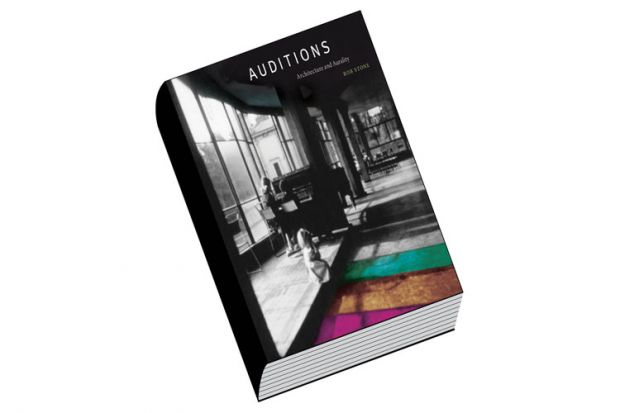Rob Stone’s new book deals with “some aspects of the frequently rather Delphic relationships that have arisen between modern sound and modern architecture”. Well, Delphic is the word. We are not in the realm of what is professionally called “sound design”, a sub-discipline of architecture with a long pedigree. Instead, we follow Stone on an imaginary journey through buildings and places in which he imagines what they might sound like. So on page 7, he recalls an undergraduate class in which he encountered Le Corbusier for the first time. He couldn’t, he writes, understand the drawings at the time. “But I do remember thinking how these images should sound.”
What follows is a decidedly baroque tour through the experience of listening to opera, Charlie Chaplin, the feminist film of Eleanor Antin, hi-fi equipment advertising, Nikolaus Pevsner, John Cage’s New York apartment, The Old Grey Whistle Test, Snow White, the architecture of Mies van der Rohe, the swimmer Greg Louganis, the now-demolished Pioneer Health Centre in Peckham, second-hand record stores, the much-missed BBC DJ John Peel, and Herbert von Karajan’s hair. There are many more things in between, along with more neologisms (“enclave urgency”, “omissibility”) than you will ever need.
Some of Stone’s characters and places I know well. I perked up at the mention of Fletcher Moss, a picturesque park on the southern edge of Manchester – but despite having read the passage a few times, I’m still at a loss to explain why it’s in there. The same mystery applies to a long sentence on page 39, one of quite a few that, no matter how I read them or how many times, still made no sense at all. And the scheme of the book sometimes seems contrived to avoid the aurality theme. I enjoyed a lot of chapter 4, “Splash”, which is largely about water. But aurality? Not a lot.
Once you accept that the theme is really a pretext for a memoir, it becomes an easier read. As a stylistic exercise it strongly recalls the work of the maverick art historian Adrian Rifkin, cited here as a mentor. Rifkin’s work, ostensibly about French art, has become ever more tangential over the years, a tissue of often alternately fascinating and infuriating detours that lead the reader miles from the main point. In fact, for Rifkin, resisting the point and those old, reactionary notions of clarté are, in fact, the point.
So it is here. Fortunately, Stone is a humane and often funny narrator, and his choice of object describes a human-scale landscape, distinct from the one you typically find in art or architectural history. His account of trying to listen to opera (in the book’s introduction) is a really good, quirky piece of musical analysis. I also liked the discussion of the libidinousness of Snow White’s Seven Dwarves, which has ensured that I will never think of them the same way again.
But whether it leads anywhere is an open question. It has a parochial quality that to all punk-remembering, Peel-listening chaps of a certain age is very familiar. And why not, as the BBC film critic Barry Norman used to say. But the question is whether this parochial lens has anything to show us about the larger world, in which, as it happens, the architecture/aurality connection is a serious business, an increasingly important subject in architectural training, and a way for architecture firms to make money. There’s a discussion to have about the growth of that phenomenon, as well as the official history of sound in architecture, which is venerable. Anyway, that would be a different book, and a different author.
Richard J. Williams is professor of contemporary visual cultures, University of Edinburgh. He is author, most recently, of Sex and Buildings: Modern Architecture and the Sexual Revolution (2013).
Auditions: Architecture and Aurality
By Rob Stone
MIT Press, 312pp, £20.95
ISBN 9780262028868
Published 26 July 2015
Register to continue
Why register?
- Registration is free and only takes a moment
- Once registered, you can read 3 articles a month
- Sign up for our newsletter
Subscribe
Or subscribe for unlimited access to:
- Unlimited access to news, views, insights & reviews
- Digital editions
- Digital access to THE’s university and college rankings analysis
Already registered or a current subscriber?
